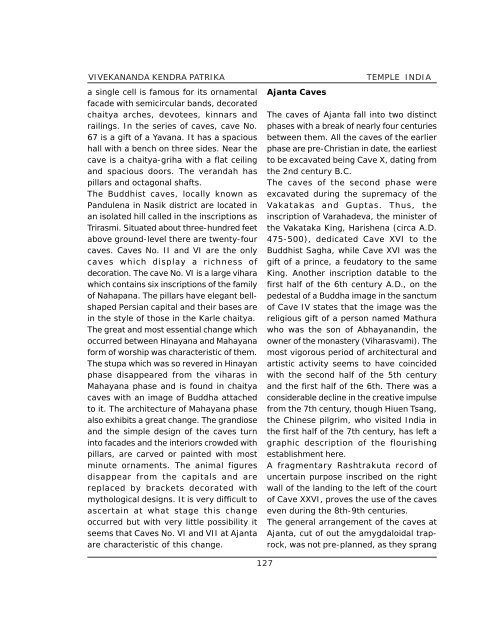Temples In India-1.pdf - Vivekananda Kendra Prakashan
Temples In India-1.pdf - Vivekananda Kendra Prakashan
Temples In India-1.pdf - Vivekananda Kendra Prakashan
Create successful ePaper yourself
Turn your PDF publications into a flip-book with our unique Google optimized e-Paper software.
VIVEKANANDA KENDRA PATRIKAa single cell is famous for its ornamentalfacade with semicircular bands, decoratedchaitya arches, devotees, kinnars andrailings. <strong>In</strong> the series of caves, cave No.67 is a gift of a Yavana. It has a spacioushall with a bench on three sides. Near thecave is a chaitya-griha with a flat ceilingand spacious doors. The verandah haspillars and octagonal shafts.The Buddhist caves, locally known asPandulena in Nasik district are located inan isolated hill called in the inscriptions asTrirasmi. Situated about three-hundred feetabove ground-level there are twenty-fourcaves. Caves No. II and VI are the onlycaves which display a richness ofdecoration. The cave No. VI is a large viharawhich contains six inscriptions of the familyof Nahapana. The pillars have elegant bellshapedPersian capital and their bases arein the style of those in the Karle chaitya.The great and most essential change whichoccurred between Hinayana and Mahayanaform of worship was characteristic of them.The stupa which was so revered in Hinayanphase disappeared from the viharas inMahayana phase and is found in chaityacaves with an image of Buddha attachedto it. The architecture of Mahayana phasealso exhibits a great change. The grandioseand the simple design of the caves turninto facades and the interiors crowded withpillars, are carved or painted with mostminute ornaments. The animal figuresdisappear from the capitals and arereplaced by brackets decorated withmythological designs. It is very difficult toascertain at what stage this changeoccurred but with very little possibility itseems that Caves No. VI and VII at Ajantaare characteristic of this change.Ajanta CavesTEMPLE INDIAThe caves of Ajanta fall into two distinctphases with a break of nearly four centuriesbetween them. All the caves of the earlierphase are pre-Christian in date, the earliestto be excavated being Cave X, dating fromthe 2nd century B.C.The caves of the second phase wereexcavated during the supremacy of theVakatakas and Guptas. Thus, theinscription of Varahadeva, the minister ofthe Vakataka King, Harishena (circa A.D.475-500), dedicated Cave XVI to theBuddhist Sagha, while Cave XVI was thegift of a prince, a feudatory to the sameKing. Another inscription datable to thefirst half of the 6th century A.D., on thepedestal of a Buddha image in the sanctumof Cave IV states that the image was thereligious gift of a person named Mathurawho was the son of Abhayanandin, theowner of the monastery (Viharasvami). Themost vigorous period of architectural andartistic activity seems to have coincidedwith the second half of the 5th centuryand the first half of the 6th. There was aconsiderable decline in the creative impulsefrom the 7th century, though Hiuen Tsang,the Chinese pilgrim, who visited <strong>In</strong>dia inthe first half of the 7th century, has left agraphic description of the flourishingestablishment here.A fragmentary Rashtrakuta record ofuncertain purpose inscribed on the rightwall of the landing to the left of the courtof Cave XXVI, proves the use of the caveseven during the 8th-9th centuries.The general arrangement of the caves atAjanta, cut of out the amygdaloidal traprock,was not pre-planned, as they sprang127
















